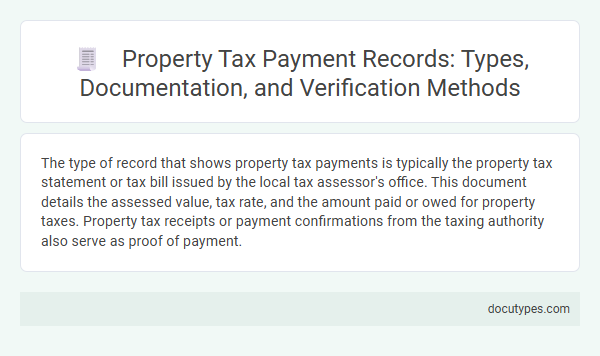The type of record that shows property tax payments is typically the property tax statement or tax bill issued by the local tax assessor's office. This document details the assessed value, tax rate, and the amount paid or owed for property taxes. Property tax receipts or payment confirmations from the taxing authority also serve as proof of payment.
Overview of Property Tax Payment Records
What type of record shows property tax payments? Property tax payment records typically appear on your property tax bill or a tax payment receipt issued by the local tax assessor's office. These documents provide detailed information about the amount paid, payment date, and tax period covered.
Types of Property Tax Payment Records
| Type of Record | Description | Common Sources |
|---|---|---|
| Property Tax Receipt | Official document issued after payment of property tax, verifying the amount paid and payment date. | County Tax Assessor's Office, Municipal Treasurer, Online Property Tax Portals |
| Tax Payment Statement | Detailed summary of property tax charges and payments over a specific period, including outstanding balances. | Local Tax Collector, County Revenue Department, Property Management Companies |
| Property Tax Ledger | Comprehensive record showing history of all property tax payments, adjustments, and penalties for a property. | County Recorder's Office, Tax Assessor's Records, Online County Databases |
| Mortgage Escrow Statements | Documents from mortgage lenders showing property tax payments made on behalf of the homeowner from escrow accounts. | Mortgage Servicers, Banks, Loan Providers |
| Online Payment Confirmations | Digital receipts or confirmation emails generated after completing online property tax transactions. | Official Government Websites, Online Property Tax Payment Systems |
Key Components of Tax Payment Documentation
Property tax payment records typically appear on documents such as tax bills, receipts, or statements issued by local taxing authorities. These records serve as proof of payment and provide details about the amount paid, payment date, and the property tax period covered.
Key components of tax payment documentation include the taxpayer's name, property identification number, and the payment amount. Dates of payment and the tax year or period are essential for verifying timely payment. Some records may also include penalties or interest if payments are made late, along with confirmation numbers or official stamps to ensure authenticity.
Digital vs. Paper Tax Payment Records
Property tax payment records provide proof of payment and are essential for verifying ownership and clearing tax liens. These records can exist in both digital and paper formats, each with distinct advantages.
- Digital Tax Payment Records - Stored electronically, they offer easy access, quick retrieval, and secure backup options for property owners and tax authorities.
- Paper Tax Payment Records - Physical documents such as receipts or stamped tax bills serve as tangible proof but can be lost or damaged over time.
- Record Verification - Both digital and paper records are accepted by municipal tax offices and courts to confirm payment history and resolve disputes.
Common Sources for Tax Payment Records
Property tax payments are documented through various official records maintained by local government agencies. These records provide proof of payment and details about tax obligations for a specific property.
- County Tax Assessor's Office - This office maintains comprehensive records of property tax payments and assessments within the county.
- Municipal Treasurer's Office - It handles tax collection and provides receipts or statements confirming payment of property taxes.
- Online Property Tax Portals - Many jurisdictions offer digital platforms where taxpayers can view and print records of their property tax payments.
Accessing these records is essential for verifying tax payment history when buying, selling, or refinancing property.
Importance of Accurate Record-Keeping
Property tax payment records are typically found on tax statements or receipts issued by local tax authorities. Maintaining accurate records of these payments is essential for verifying ownership and avoiding disputes during property sales or assessments. Proper documentation ensures compliance with tax regulations and supports financial planning for property owners.
Methods for Verifying Property Tax Payments
Property tax payments are typically documented in tax payment records maintained by local government tax assessors or treasurers. Methods for verifying property tax payments include reviewing official tax receipts, accessing online municipal tax portals, and consulting county clerk or tax collector offices. These sources provide accurate and up-to-date information essential for confirming the status of property tax obligations.
Legal Requirements for Record Retention
Property tax payment records are essential for verifying tax compliance and fulfilling legal obligations. You should keep these records organized to meet legal requirements for record retention.
- Property Tax Receipts - These documents show proof of payment and are issued by the local tax authority after payment is made.
- County or Municipal Tax Statements - These statements detail the assessed property value and taxes owed, serving as official records for taxation purposes.
- Retention Period Requirements - Most jurisdictions require property tax records to be retained for at least three to seven years for audit and legal verification.
Challenges in Accessing Tax Payment Records
Property tax payment records are typically documented in official county tax assessor or treasurer databases. These records provide detailed information on payment history, amounts paid, and outstanding balances associated with specific properties.
Accessing accurate tax payment records can be challenging due to inconsistent record-keeping practices across different jurisdictions. Restrictions such as privacy laws and limited online availability further complicate obtaining timely and comprehensive data.
What Type of Record Shows Property Tax Payments? Infographic

